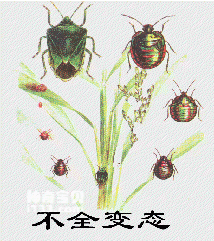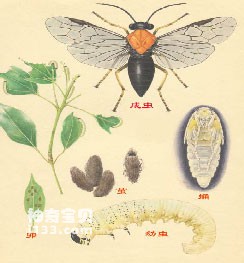The life of some animals lasts for decades, while the life of insects often only lasts for a short time. The ontogenetic history of an individual (whether it is an egg or a larva) from the time it leaves its mother to the time it reaches sexual maturity and produces offspring is called a generation. A generation is the entire developmental process from birth to death (non-accidental death). The development history of an insect in one year, more precisely, the development process from the beginning of the overwintering insect state in that year to the end of overwintering in the second year, is called life history, or life history for short.
Various insects take different times to complete one generation, and the number of generations they can complete in one year is also different. Some insects only complete one generation per year and are called monotonic insects. Insects that have more than two generations a year are called polymorphic insects. The names of borer borer and borer borer are named according to the number of generations they occur in a year. Some insects can complete many generations in a year, and aphids that damage cotton can complete 20-30 generations in a year. In other species, it often takes 2-3 years to complete one generation, and the longest even takes more than ten years, such as the seventeen-year cicada.
After an insect hatches from an egg, it needs to undergo a series of changes in external form and internal tissue before it can develop into a sexually mature adult. This change is called metamorphosis. After a long period of evolution, insects have undergone many types of metamorphosis, including the differentiation between adult and larval states, the acquisition of wings, and the special adaptation to the living environment in their young stages. There are mainly five basic types:
1. Metamorphosis of increased joints: Metamorphosis of increased joints is a primitive metamorphosis type retained when it evolved from Myriapoda. Among the Insecta, only the Protocera of the Apterygian subclass develop in the form of metamorphosis. The characteristic of this metamorphosis is that in addition to the difference in individual size and sexual organ development between the juvenile and mature stages, the number of abdominal segments gradually increases: the abdomen of the newly hatched protocercoid has only 9 segments, and later it has 9 segments after hatching. Gradually add 3 sections to the total number of 12 sections. The 12th segment is the tail segment, and the three additional segments are all derived from the 8th segment.
2. Epimetamorphosis: This is the type of metamorphosis possessed by all orders in the subclass Aptera except Protocerda (Colombula, Thysanoderma and Diptera). The characteristic of epimetamorphosis is that the young hatched from eggs have basically acquired the characteristics of adults. In post-embryonic development, only the growth of individuals, the maturation of sexual organs, the increase in the number of antennae and caudal whiskers, and the growth of scales and setae are the main features of post-embryonic development. There are changes in other aspects, but generally speaking these changes are not very obvious. Another characteristic of epimetamorphosis is continued shedding of skin in the adult stage.
3. Proto-metamorphosis: Proto-metamorphosis is the most primitive type of metamorphosis among winged insects. Only the order Ephemeroptera has this type of metamorphosis. It is characterized by a sub-adult stage as it transitions from juvenile to true adult stage. The sub-adult stage is a very short one, sometimes less than an hour, in which it looks like the adult and can fly.

4. Incomplete metamorphosis: This type of metamorphosis has only three stages, namely egg stage, larval stage and adult stage. The characteristics of the adult stage gradually appear as the juvenile stage grows and develops, and the wings develop outside the juvenile stage. The main difference between incomplete metamorphosis and original metamorphosis is that the adult stage no longer sheds its skin, and the larval stage is oligopodal (only 3 pairs of thoracic legs and no gastropods). The most typical insects with incomplete metamorphosis include: Orthoptera, Isoptera, Stick Insects, Mantises, Blattales, Dermoptera, Rodents, Spinipeda, Hemiptera, Homoptera, etc. The terrestrial larvae of these insects are called nymphs. The larvae of the order Odonata and the order Odonata are aquatic, so their larvae are relatively specialized and are called larvae (modified from the Caiwanzhi picture).

5. Complete metamorphosis: This type of metamorphosis has 4 stages: egg, larvae, pupa and adult. Holometabolous larvae are not only completely different in external form and internal organs from adults, but also often have different living habits. For example, butterfly larvae are multi-legged caterpillars that feed on plant leaves; adults are beautiful butterflies that mostly feed on nectar and water. In holometabolism, the larvae of some insects have very different lifestyles between each instar. Therefore, there are great differences in body shape, structure, etc. accordingly. This developmental process appears to be more complex, so it is also called metamorphosis. Metamorphosis is a phenomenon unique to some parasitic insects. Coriander is a good example of anamorphosis.
animal tags:
We created this article in conjunction with AI technology, then made sure it was fact-checked and edited by a Animals Top editor.